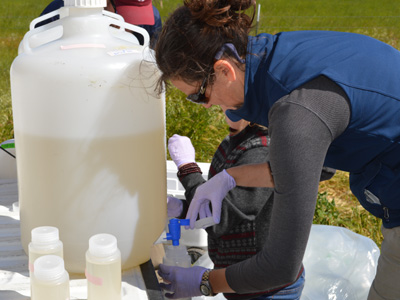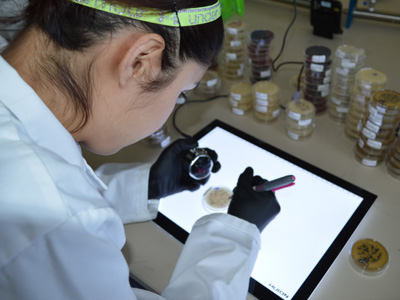Agriculture Water Quality Important Component in Food Safety
Chris Brunner, May 11, 2016

In field studies Melissa Partyka and Jennifer Chase transfer collected water into small liter bottles for transport back to the Atwill Water and Foodborne Zoonotic Disease Laboratory on the UC Davis campus.
The FDA Food Safety Modernization Act (FSMA) Produce Safety Rule is now final. It’s pronounced FIZZ-mah, and it marks a change in the way we regulate food safety. Rather than waiting for an outbreak to trigger a cleanup, now the food system, from farm to fork, will take a more proactive approach.
For the first time, science-based minimum standards for the safe growing, harvesting, packing, and holding of fruits and vegetables grown for human consumption, have been established, through the FSMA Produce Safety Rule.
Farms covered by the Produce Safety Rule will be held to certain standards intended to reduce the presence of potentially dangerous bacteria in the food supply. Ultimately this could help reduce the 128,000 estimated annual hospitalizations from foodborne illnesses each year in the U.S.
Over the course of the next one to four years the compliance dates will be implemented per the size and income of the farms. Compliance standards in the FSMA Final Rule on Produce Safety, will have growers and producers playing an important role in food safety. Since water is vital to the growth of produce, it’s one of the important factors in pre-harvest food safety.
Produce associations, state agriculture departments, and university co-operative extension programs, will be assisting growers and producers by providing clarification guidance of the agricultural water requirements in the Produce Safety Rule. The FDA rule establishes “two sets of criteria for microbial water quality, both of which are based on the presence of generic E. coli, which can indicate the presence of fecal contamination.”
The Produce Safety Rule requires growers to initially establish a Microbial Water Quality Profile (MWQP). They are required to collect 20 water samples as close as practical to harvest over a minimum of at least 2 to maximum 4 years. The water quality profile is based on the levels of generic E. coli in growers and producers agricultural water.
Another way of looking at this is, if the water samples from the irrigation water indicate a particularly high level of coliform bacteria, this could be an indication of a particularly high level of fecal contamination. If the grower or producer finds the irrigation water has very low coliform counts it’s an indication the water is reasonably safe for crops.

Claudia Bonilla a junior specialist with the Atwill lab counts bacterial colonies to determine the number in a single sample.
Melissa Partyka a staff research associate, Ronald Bond, a water quality researcher, and Jennifer Chase, laboratory manager, with the Atwill Water and Foodborne Zoonotic Disease Laboratory with WIFSS, as well as other technicians in the lab, are working with the FDA, on research directly related to the FSMA food safety rule for agriculture water. The team’s research will benefit producers in increasing understanding how best to comply with the new food safety regulations. The Atwill lab team will be holding workshops in Washington State for fruit tree growers where they will help growers understand how best to take and handle water samples.
With the support of staff such as those in the Atwill lab, and university co-operative extension programs, and other state agencies, growers and producers will be in good hands as they begin to focus more on prevention and take a more active approach to food safety.
